Transforming Broadcasting with Cutting-edge Audio via IP Technologies toward a Integrated Tomorrow
Transforming Broadcasting with Cutting-edge Audio via IP Technologies toward a Integrated Tomorrow
Blog Article
This world of broadcasting is experiencing a major transformation due to innovative audio via IP (AoIP) technologies. Such advancements are revolutionizing the way audio content is produced, distributed, and received. Audio over IP refers to the method of sending audio signals over a digital network, utilizing Internet Protocol (IP) rather than traditional analog techniques. This change not only improves the quality of audio delivery but also provides media professionals with greater freedom and authority over their programming.
One major advantage of audio over IP systems is its ability to link various devices and technologies seamlessly. Classic broadcasting often depended on complex wiring and tangible connections, which could be burdensome and limited. With AoIP, broadcasters can readily interface mics, mixers, and additional equipment through a shared network. This convergence allows for remote broadcasting and live streaming from almost any location, making it simpler to reach listeners across the world. As a consequence, broadcasters can respond quickly to ongoing events and listener requests, leading to more dynamic and captivating programs.
Moreover, AoIP technology supports high-quality audio standards that improve the auditory encounter. In contrast to traditional broadcasting techniques, which may compromise sound quality, audio over IP can preserve the integrity of the audio stream during the transmission process. This means that listeners can experience crisper and richer sound, regardless of whether they are listening in via terrestrial radio, broadcasting over the internet, or using mobile devices. The ability to provide premium audio is particularly important for music and talk shows, where every nuance matters to the listeners.
Additionally, the implementation of audio over IP systems can lead to financial efficiencies for media companies. By using existing infrastructure systems, companies can remove the need for costly hardware and large-scale cabling. This not only lowers initial costs but also lowers maintenance expenses over time. Broadcasters can distribute resources more effectively, focusing on production and human resources development. As a result, the entire broadcasting industry can gain from increased innovation and creativity, as funds are redirected toward improving programming and engaging with listeners.
In summary, the transition towards audio over IP systems is transforming the broadcasting landscape. By enabling smooth links, enhancing audio quality, and lowering costs, AoIP is clearing the path to a better integrated future in address media. As broadcasters continue to adapt to these changes, they will be better equipped to meet the needs of their listeners, produce compelling programs, and stay competitive in an ever-evolving industry. The prospects of broadcasting is bright, and audio over IP will take a key role in defining how we experience audio content in the years to follow.